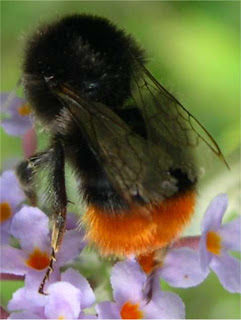Commonly seen in gardens and hedgerows, the red-tailed bumble bee often nests under stones or slabs. This species is unlikely to sting unless its nest is endangered. However, red-tailed bumble bees will often fly menacingly around the heads of intruders, in an attempt to prevent damage to their nests.
Only the young fertilised queen survives the winter, having hibernated in a protected place such as in a hole or under moss. She emerges in spring and starts up her own colony or takes over an existing one. The queen makes pots of wax and pollen into which the first eggs are laid.
After about three weeks, the first infertile female workers emerge and take over the nectar and pollen gathering and cell building, while the queen concentrates on egg laying. The larvae are reared on pollen and nectar.
Male bees appear in summer and towards the end of the season both male and female bumble bees fly out and mate. The males are not allowed to re-enter the nest after mating and soon die. The fertilised queen starts searching for a safe place to hibernate but both the workers and the old queen die with the first frosts or spell of cold weather.
Bumblebees are now much less common in the countryside and gardens are an important habitat for these species, where they reward us by pollinating plants such as apple trees.
You can encourage them by making artificial nest boxes.
- Lie a large plastic plant pot on its side.
- Line the inside with chicken wire, and then inside this place a layer of capoc - upholsterers' cotton. Don't use artificial fibre as bees get tangled up in it.
- Fill the centre of the nest with hay and place an inverted plant-pot base over the top of the plant pot, securing it in place with wires fed through holes drilled in the side.
- Finally, drill a hole about 2 centimetres wide into the centre of the plant-pot base and insert a short length of hollow pipe - which becomes the entrance hole.
- Place the nest in a sunny border amongst vegetation and wait for the bees to find it. If you have white clover in the lawn, give it a flowery break from mowing in the summer - this bee loves clover flowers.
Interesting fact:
Bombus lapidarius
.....................lapidarius comes from the Latin meaning stone therefore common names include:
- Stone bumble bee (it commonly nests under stones)
- Red tailed bee (it is one of the bees that has an orangey red tail)
- Large red-tailed bumblebee
Kingdom Animalia This contains all the species of animals.
Phylum Arthropoda or Uniramia Animals without backbones, but with jointed legs.
Class Insecta or Hexapoda Insects, as the name hexapoda suggests, animals that have six legs, at least most of the adults have.
Order Hymenoptera Bees, wasps, ants and sawflies.
Superfamily Apoidea Bees and some wasps.
Family Apidae Bees.
Genus Bombus Bumblebees.
Links:
Buglife Natural England

No comments:
Post a Comment